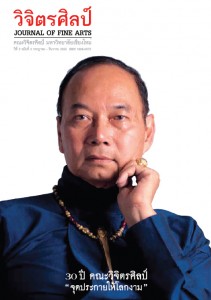รูปแบบเครื่องแต่งกายในพิธีกรรมฟ้อนผีของชาวล้านนา
Main Article Content
Abstract
จากการศึกษาวิจัยพบว่า พิธีกรรมฟ้อนผียังคงถือปฏิบัติกันอย่างมากในเขตจังหวัดเชียงใหม่ จังหวัดลำพูน และจังหวัดลำปาง โดยเหตุผลแรงจูงใจในการประกอบพิธีกรรมนั้นอาจจะมิใช่เพียงแค่การเคารพบูชาวิญญาณบรรพบุรุษเพียงอย่างเดียว แต่เป็นการสื่อแสดงถึงความมีอำนาจและความมีหน้ามีตาในสังคม ซึ่งเครื่องแต่งกายก็สามารถแสดงถึงสัญญะในด้านนี้ได้เป็นอย่างดี นอกจากนี้ ในมิติทางความเชื่อดั้งเดิมนั้นยังเป็นแรงผลักดันสำคัญให้เกิดหลักปฏิบัติทางจารีตอันเคร่งครัด เกี่ยวกับเครื่องแต่งกายและเครื่องประดับไปจนถึงส่วนประกอบต่างๆ ซึ่งได้เชื่อมโยงไปถึงนัยความหมายของรากเหง้าแห่งเผ่าพันธุ์ หรือแม้กระทั่งการนำไปใช้ในเชิงสัญลักษณ์อันสลับซับซ้อนมากขึ้น เช่น ภูมิหลัง ที่มา หรือระดับชั้นของสายผีในแต่ละตระกูล เช่น กลุ่มตระกูลสายผีมด กลุ่มตระกูลสายผีเม็ง หรือแม้กระทั่งกลุ่มสายผีที่แพร่กระจายเข้ามาจากต่างประเทศ เช่น จีนและอินเดีย เป็นต้น
เครื่องแต่งกายฟ้อนผีได้ช่วยเพิ่มสีสันและความงามจนกลายเป็นเอกลักษณ์อันโดดเด่นแห่งพิธีกรรม สามารถแสดงถึงทัศนคติด้านสุนทรียะขั้นพื้นฐานที่ชาวบ้านได้แสดงออกมาอย่างจริงใจ โดยอาศัยพิธีกรรมการฟ้อนรำเป็นสื่อความหมายเพื่อติดต่อกับอำนาจอันศักดิ์สิทธิ์อย่างเคารพนบนอบ ทั้งนี้ก็เพื่อให้สิ่งศักดิ์สิทธิ์ตามความเชื่อแห่งตนนั้นเกิดความพึงพอใจแล้วช่วยเหลือจนสามารถบรรลุวัตถุประสงค์ต่างๆ ได้ เช่น การฟ้อนรำเพื่อให้เกิดความอุดมสมบูรณ์ การฟ้อนรำเพื่อให้หายจากอาการเจ็บไข้ได้ป่วย หรือฟ้อนรำเพื่อแสดงออกถึงความกตัญญูกตเวทีต่อบรรพบุรุษ เป็นต้น
ผลจากการศึกษาวิจัยในครั้งนี้ ผู้วิจัยคาดว่าจะเป็นประโยชน์ในเชิงวิชาการต่อนักศึกษาและบุคคลที่มีความสนใจในเรื่องราวของเครื่องแต่งกายอันมีผลสืบเนื่องมาจากคติความเชื่อเรื่องการฟ้อนผีของชาวล้านนา
The Study of Clothing Pattern in Lan Na Ritual “FON PEE” (Spiritual Dance).
There is a definite characteristic in terms of forms and patterns of clothing used in spiritual dance of Lan Na people. We found that the spiritual dances are still being performed widely in Chiang Mai, Lamphun and Lampang province. The ritual’s inspiration is not entirely for paying respect to the souls of ancestors but to reflect the performer’s influence and wealth in the society. The clothing is an effective semiotical means in this aspect. Traditional belief is the key factor for the strict ritual practice regarding clothing and ornaments which also closely linked to the roots of the ethnic group. They also apply in the more complicated semiology such as the background, the origin or even the classes of the spirits such as the spiritual group of Phee-Mod, Phee-Meng or other groups that are from China and India. The spiritual dance clothes add the colorful atmosphere and beauty to the uniqueness of the rituals. This indicates the esthetical attitudes and fundamental artistic value that local people sincerely present via the performance aiming at connecting with the holy power with respect. They expect that the spirits and other mythical beings according to the belief’s will be satisfied and help them achieving all aims such as dancing for expected abundance, fertility or being free from all sickness.
The researcher hopes that this result will be beneficial for the students and interested people in the field of clothing, influenced by the belief of spiritual dancing of Lan Na.


